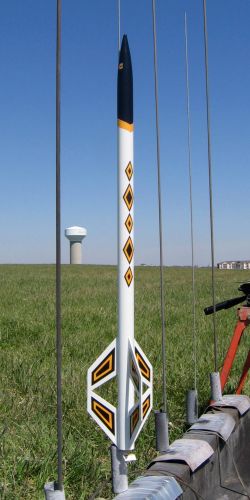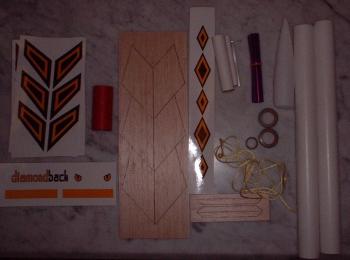| Construction Rating: | starstarstarstarstar_border |
| Flight Rating: | starstarstarstarstar_border |
| Overall Rating: | starstarstarstarstar_border |
| Manufacturer: | Apogee Components  |

Brief:
Looks can be deceiving on this bird--it's a single-stage that could pass for a two-stager and is an 18mm bird that is begging to be promoted to 24mm. It's good to see Apogee add something to their modroc line, especially something with such cool looking fins.
Construction:
As is typical with Apogee, my kit arrived well packed a mere two days after placing the order along with a couple free goodies (plastic chute and CD with some video building tips). Parts were generally very good quality although the plastic nose cone had a small dent, which apparently happened as it was being drawn from the mold. The parts for this kit include:
- 18mm motor tube
- metal hook
- 13/18 centering ring/block
- 29mm body tubes (2x13"), 1 coupler
- 29/18 centering rings
- Plastic nose cone
- Laser cut balsa fins
- Mylar streamer 4x45
- Kevlar shock cord (300#)
- 1/4" launch lug
- Peel and stick decals
The instructions for this are very good with plenty of computer generated drawings and check boxes for each step of the way. There are a total of 8 black and white pages and 24 construction steps. It is accurately rated a skill level 2 kit, as the most challenging aspect is masking the slightly tricky paint scheme. I managed to build mine in about 4 hours plus another 3-4 for finishing.
Construction begins by separating out the fins. I typically take care of applying a coat or two of Elmer's Fill 'n' Finish at this point, too, as it's a heck of a lot easier to sand them down loose than after bonding to the tube. There are 6 identical fins for this plus 3 end pieces so there's plenty of balsa grain to fill.
 To fit the kit in a small bag/shipping box, the 26" body is composed of two pieces of 29mm tubing and a coupler. I made the mistake of using a thin layer of yellow glue, so that the 2.5" long coupler barely made it 1" in before the glue grabbed it and I couldn't budge it. Same thing happened on the other side, leaving me with an exposed 1/2" of coupler. I wound up having to cut it out and make one of my own from spare tubing stock. While I chalk this up to my own foolishness for not sanding down the coupler a bit first and using white glue, I think the 2.5" coupler is a bit overkill and 1-1.5" would be fine, as well as less likely to bind up when inserting.
To fit the kit in a small bag/shipping box, the 26" body is composed of two pieces of 29mm tubing and a coupler. I made the mistake of using a thin layer of yellow glue, so that the 2.5" long coupler barely made it 1" in before the glue grabbed it and I couldn't budge it. Same thing happened on the other side, leaving me with an exposed 1/2" of coupler. I wound up having to cut it out and make one of my own from spare tubing stock. While I chalk this up to my own foolishness for not sanding down the coupler a bit first and using white glue, I think the 2.5" coupler is a bit overkill and 1-1.5" would be fine, as well as less likely to bind up when inserting.
The motor tube assembly is the standard 18mm tube with a metal hook, a pair of external centering rings, and an internal ring serving as a block. Note that the Kevlar shock cord is anchored to the forward ring. I love Apogee's Kevlar® but have to admit the 300# stuff included in this kit is a bit over the top for an 18mm kit and think the thinner 150# would serve just as well.
Prior to bonding to the body, the fins must first be assembled. The assembly consists of a pair of fins set in opposing orientation joined at the tip edges by a balsa brace. This keeps everything lined up nicely and prevents fin flutter. Once the fins are put together, they are then attached to the body tube at standard 120-degree orientation.
By the time you get to attaching the launch lug, you'll probably be scratching your head wondering why this has an 18mm motor tube. Between the 29mm main body tube, the 300# Kevlar, and the 1/4" launch lug, this has the look and feel of a 24mm mid-power kit but seems to have been downsized a bit for the 18mm market. I would think serious rocketeers will be kit bashing this and 24mm will be the norm if not 29mm (although with a 29mm motor on board, you may never see it again). I thought the 1/4" lug was just plain silly, so substituted a standard 1/8" lug instead.
 Finishing:
Finishing:
Finishing is pretty easy on this for such a neat looking rocket. I filled the tube spirals with some Elmer's Wood Filler then applied two light coats of primer. After sanding down with 400 grit wet paper, I went with three thin coats of Krylon gloss white. I generally prefer Rustoleum to Krylon, but Krylon dries much more quickly and I wanted to get this in the air within 1-2 days.
The accent coat is black, but rather than a straight/simple mask, you are advised to mask a tapered line, giving the nose a bit of a snake-like appearance. The instructions make the taper pretty easy, providing dimensions and marking points. The only improvement I'd make to this is to suggest citing the dimensions from the edge of the body tube rather than the edge of the cone. It's a little hard keeping a ruler edge aligned with a nose cone tip and the body tube at the same time.
For a finishing touch, this kit comes with some sharp looking peel and stick decals. Personally, I hate peel and stick, but I will say this kit uses some very good quality stickers. Still, I just don't think they have the same look as waterslide and they're not very forgiving if you need to realign them slightly after they've touched the rocket.
Construction Rating: 4 out of 5
Flight:
The header card for the kit claims this is 5 ounces, but mine weighed in at 2.8 ounces fully prepped (excluding motor). Given the large fins, I figured this to be draggy, so went with a C6-3 for first flight. That turned out to be an excellent choice. The boost in light winds was perfectly straight up with no roll and the deployment just a hair early but not enough to warrant a 5.
Recovery:
Given the weight of only 2.8 ounces, there was no way was I going to risk losing this to the boomer thermals on our field by using the 32" plastic chute. Instead, I swapped out for an 18" nylon, which was more than adequate for the job. Recovery was fine and the rocket was undamaged, eager for another flight.
Flight Rating: 4 out of 5
Summary:
The only con I can offer up on this is the request to modify this to a 24mm kit, or if sticking with 18mm, at least scale down the Kevlar and lug. I'd also love to see this with waterslide decals but suspect that would have driven up the cost a bit.
Pros are the cool fins and design, and the fact that it's a reliable flier.
Overall Rating: 4 out of 5
Other Reviews
- Apogee Components Diamond Back By Sandy Houston (April 17, 2017)
The Apogee Diamondback is an 18mm single stage streamer recovery model which stands just over 30” tall. While it does have three fins and a nosecone, this is not a typical 3FNC like you would find at the local superstore. This kit's pedigree is obviously from a stable which is rooted in mid-power rockets, as the kit features components that tend toward the mid-power standards. The ...
 |
 |
Flights
 |
 |
Sponsored Ads
 |
 |












J.A.L. (June 21, 2009)